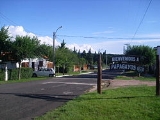
Papagayos
Encyclopedia
Papagayos is a village in Chacabuco Department, San Luis Province
, Argentina
. Among the small towns that are at the feet of the Comechingones Mountains, Papagayos stands out by its particular landscape of Caranday
Palms.
It borders Villa Larca to the north, Tilisarao to the west, Villa del Carmen to the south and to the east, Córdoba Province
.
It has around 750 inhabitants. Its climate is mainly dry with a little summer precipitation.
(Cyanoliseus patagonus) that they found in the zone by that name.
San Luis Province
San Luis is a province of Argentina located near the geographical center of the country . Neighboring provinces are, from the north clockwise, La Rioja, Córdoba, La Pampa, Mendoza and San Juan.-History:...
, Argentina
Argentina
Argentina , officially the Argentine Republic , is the second largest country in South America by land area, after Brazil. It is constituted as a federation of 23 provinces and an autonomous city, Buenos Aires...
. Among the small towns that are at the feet of the Comechingones Mountains, Papagayos stands out by its particular landscape of Caranday
Trithrinax campestris
Trithrinax campestris or caranday palm is a South American arecaceae palm native of Uruguayan and northeastern Argentine sabanas, where it shares its habitat with Copernicia alba among others and extends also to the summits of mountain ranges of Sierras de Córdoba and Sierras de San Luis. It is a...
Palms.
It borders Villa Larca to the north, Tilisarao to the west, Villa del Carmen to the south and to the east, Córdoba Province
Córdoba Province (Argentina)
Córdoba is a province of Argentina, located in the center of the country. Neighboring provinces are : Santiago del Estero, Santa Fe, Buenos Aires, La Pampa, San Luis, La Rioja and Catamarca...
.
It has around 750 inhabitants. Its climate is mainly dry with a little summer precipitation.
Toponymy
There are two theories about Papagayos' name: some people affirm that it derives from “Papa-Gallo” name that the natives gave to a used wild plant with medicinal aims. Another theory says that it may be a confusion of the colonists, calling the Burrowing ParakeetBurrowing Parakeet
The Burrowing Parrot is a bird species in the parrot family. It belongs to the smaller long-tailed Arinae , and is also known as Patagonian Conure. The Burrowing Parrot belongs to the monotypic genus Cyanoliseus, but the species is not monotypic, having several subspecies.It is mainly found in...
(Cyanoliseus patagonus) that they found in the zone by that name.

